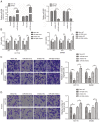MicroRNA-206 inhibits the proliferation, migration and invasion of colorectal cancer cells by regulating the c-Met/AKT/GSK-3β pathway
- PMID: 33633805
- PMCID: PMC7877959
- DOI: 10.3892/ol.2020.12408
MicroRNA-206 inhibits the proliferation, migration and invasion of colorectal cancer cells by regulating the c-Met/AKT/GSK-3β pathway
Abstract
An imbalance in microRNA (miRNA/miR) expression is closely associated with tumorigenesis and progression. miR-206 is downregulated in different types of tumors, including colorectal cancer (CRC). However, the effects of miR-206 on the progression of CRC, and its underlying molecular mechanisms are yet to be elucidated. The present study aimed to investigate the effects of miR-206 on the proliferation, migration and invasion of colorectal cancer cells, and determine its potential molecular mechanism. The results of the present study demonstrated that the expression levels of miR-206 and c-Met were affected in HCT116 and SW480 cells by transfected with miR-206 mimic, inhibitor or small interfering RNA-c-Met. A Dual-luciferase reporter assay was performed to identify the miRNA targets. Cell proliferation, migration and invasion assays were also performed. The results demonstrated that overexpression of miR-206 significantly decreased the viability of HCT116 and SW480 cells. The results of the Transwell assay indicated that the cell migratory and invasive abilities were inhibited following transfection with miR-206 mimic. As a target of miR-206, knockdown of c-Met significantly suppressed cell viability, migration and invasion. In addition, c-Met knockdown or overexpression of miR-206 inhibited activation of the AKT/GSK-3β pathway. Collectively, these results suggest that miR-206 suppresses the proliferation, migration and invasion of CRC cells by targeting the c-Met/AKT/GSK-3β pathway.
Keywords: c-Met; colorectal cancer; invasion; microRNA-206; migration; proliferation.
Copyright: © Lyu et al.
Figures




Similar articles
-
MiR-19a-3p regulates the Forkhead box F2-mediated Wnt/β-catenin signaling pathway and affects the biological functions of colorectal cancer cells.World J Gastroenterol. 2020 Feb 14;26(6):627-644. doi: 10.3748/wjg.v26.i6.627. World J Gastroenterol. 2020. PMID: 32103872 Free PMC article.
-
MicroRNA-128 targeting RPN2 inhibits cell proliferation and migration through the Akt-p53-cyclin pathway in colorectal cancer cells.Oncol Lett. 2018 Dec;16(6):6940-6949. doi: 10.3892/ol.2018.9506. Epub 2018 Sep 26. Oncol Lett. 2018. PMID: 30546426 Free PMC article.
-
Long noncoding RNA SNHG14 accelerates cell proliferation, migration, invasion and suppresses apoptosis in colorectal cancer cells by targeting miR-944/KRAS axis through PI3K/AKT pathway.Eur Rev Med Pharmacol Sci. 2019 Nov;23(22):9871-9881. doi: 10.26355/eurrev_201911_19551. Eur Rev Med Pharmacol Sci. 2019. PMID: 31799655
-
miR-141 Inhibits Proliferation and Migration of Colorectal Cancer SW480 Cells.Anticancer Res. 2017 Aug;37(8):4345-4352. doi: 10.21873/anticanres.11828. Anticancer Res. 2017. PMID: 28739727
-
MiR-450a-5p Inhibits Gastric Cancer Cell Proliferation, Migration, and Invasion and Promotes Apoptosis via Targeting CREB1 and Inhibiting AKT/GSK-3β Signaling Pathway.Front Oncol. 2021 Mar 29;11:633366. doi: 10.3389/fonc.2021.633366. eCollection 2021. Front Oncol. 2021. PMID: 33854971 Free PMC article.
Cited by
-
The multifaceted role of microRNAs in colorectal cancer: pathogenesis and therapeutic implications.Noncoding RNA Res. 2025 May 23;14:65-95. doi: 10.1016/j.ncrna.2025.05.012. eCollection 2025 Oct. Noncoding RNA Res. 2025. PMID: 40535722 Free PMC article. Review.
-
Long non-coding RNA signatures and related signaling pathway in T-cell acute lymphoblastic leukemia.Clin Transl Oncol. 2022 Nov;24(11):2081-2089. doi: 10.1007/s12094-022-02886-9. Epub 2022 Jul 19. Clin Transl Oncol. 2022. PMID: 35852681 Review.
-
Dysregulation of transcripts SMAD4-209 and SMAD4-213 and their respective promoters in colon cancer cell lines.J Cancer. 2024 Aug 6;15(15):5118-5131. doi: 10.7150/jca.98911. eCollection 2024. J Cancer. 2024. PMID: 39132157 Free PMC article.
-
Interaction between miR‑206 and lncRNA MALAT1 in regulating viability and invasion in hepatocellular carcinoma.Oncol Lett. 2023 Nov 7;27(1):5. doi: 10.3892/ol.2023.14138. eCollection 2024 Jan. Oncol Lett. 2023. PMID: 38028177 Free PMC article.
-
Downregulation of Serum miR-133b and miR-206 Associate with Clinical Outcomes of Progression as Monitoring Biomarkers for Metastasis Colorectal Cancer Patients.Microrna. 2024;13(1):56-62. doi: 10.2174/0122115366266024240101075745. Microrna. 2024. PMID: 38231064 Free PMC article.
References
-
- Rupaimoole R, Calin GA, Lopez-Berestein G, Sood AK. miRNA deregulation in cancer cells and the tumor microenvironment. Cancer Discov. 2016;6:235–246. doi: 10.1158/2159-8290.CD-15-0893. - DOI - PMC - PubMed
LinkOut - more resources
Full Text Sources
Research Materials
Miscellaneous
